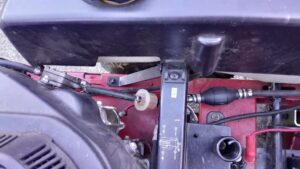SiK is an inexpensive data radio commonly used by UAVs.
At least two of the ‘ground station’ applications incorporate facility for firmware upgrade, but if you aren’t using them for their main purpose, it is a huge installation just to upgrade the SiK radio.

Above is an inexpensive C2 programmer with DIY pogo pin adapter, one of may options. A C2 programmer is needed to write the bootloader.
The SiK radio project publishes a python script at https://github.com/ArduPilot/SiK/blob/master/Firmware/tools/uploader.py . This article gives a revised version that works on a HM-TRP radio under Windows 11.
The firmware was v2.2 sourced from https://firmware.ardupilot.org/SiK/stable/ .
Here is the revised Python script:
#next line fails in Windows
##!/usr/bin/env python3
#
# Serial firmware uploader for the SiK bootloader
#
import argparse
import binascii
import glob
import serial
import sys
import time
if sys.version_info.major < 3:
print("This tool requires python3")
sys.exit(1)
class Firmware(object):
"""Loads a firmware file"""
# parse a single IntelHex line and obtain the byte array and address
def __parseline(self, line):
# ignore lines not beginning with :
if line[0] != ":":
return
# parse the header off the line
hexstr = line.rstrip()[1:-2]
binstr = binascii.unhexlify(hexstr)
command = binstr[3]
# only type 0 and 4 records are interesting
if command == 4 and binstr[0] == 0x02 and (binstr[1] << 8) + binstr[2] == 0x0000:
self.upperaddress = (binstr[4] << 8) + binstr[5]
self.bankingDeteted = True
elif command == 0:
address = (binstr[1] << 8) + binstr[2] + (self.upperaddress << 16) bytes = bytearray(binstr[4:]) if self.upperaddress in self.sanity_check: self.sanity_check[self.upperaddress][0] += len(bytes) if self.sanity_check[self.upperaddress][1] > (binstr[1] << 8) + binstr[2]:
self.sanity_check[self.upperaddress][1] = (binstr[1] << 8) + binstr[2]
if self.sanity_check[self.upperaddress][2] < (binstr[1] << 8) + binstr[2] + len(bytes):
self.sanity_check[self.upperaddress][2] = (binstr[1] << 8) + binstr[2] + len(bytes)
else:
self.sanity_check[self.upperaddress] = []
self.sanity_check[self.upperaddress].append(len(bytes))
self.sanity_check[self.upperaddress].append((binstr[1] << 8) + binstr[2])
self.sanity_check[self.upperaddress].append((binstr[1] << 8) + binstr[2] + len(bytes)) self.__insert(address, bytes) # insert the byte array into the ranges dictionary, merging as we go def __insert(self, address, bytes): # look for a range that immediately follows this one candidate = address + len(bytes) if candidate in self.ranges: # found one, remove from ranges and merge it nextbytes = self.ranges.pop(candidate) bytes.extend(nextbytes) # iterate the existing ranges looking for one that precedes this for candidate in list(self.ranges.keys()): prevlen = len(self.ranges[candidate]) if (candidate + prevlen) == address: self.ranges[candidate].extend(bytes) return # just insert it self.ranges[address] = bytes def __init__(self, path): self.ranges = dict() self.upperaddress = 0x0000 self.bankingDeteted = False self.sanity_check = dict() # read the file # XXX should have some file metadata here too ... f = open(path, "r") for line in f: self.__parseline(line) def code(self): return self.ranges class Uploader(object): """Uploads a firmware file to the SiK bootloader""" NOP = chr(0x00) OK = chr(0x10) FAILED = chr(0x11) INSYNC = chr(0x12) EOC = chr(0x20) GET_SYNC = chr(0x21) GET_DEVICE = chr(0x22) CHIP_ERASE = chr(0x23) LOAD_ADDRESS = chr(0x24) PROG_FLASH = chr(0x25) READ_FLASH = chr(0x26) PROG_MULTI = chr(0x27) READ_MULTI = chr(0x28) PARAM_ERASE = chr(0x29) REBOOT = chr(0x30) PROG_MULTI_MAX = 32 # 64 causes serial hangs with some USB-serial adapters READ_MULTI_MAX = 255 READ_MULTI_MAX = PROG_MULTI_MAX #fix buffer overrun on verify with FTDI FT-232RL BANK_PROGRAMING = -1 def __init__(self, portname, atbaudrate=57600, use_mavlink=False, mavport=0, debug=0): print(("Connecting to %s" % portname)) if use_mavlink: from pymavlink import mavutil self.port = mavutil.MavlinkSerialPort(portname, 115200, devnum=mavport, timeout=3, debug=debug) else: self.port = serial.Serial(portname, 115200, timeout=3) self.atbaudrate = atbaudrate self._debug = debug self.percent = -1 if use_mavlink: # we can send a bit more on mavlink Uploader.PROG_MULTI_MAX = 64 def debug(self, s, level=1): """write some debug text""" if self._debug >= level:
print(s)
def __send(self, c):
if type(c) is str:
self.port.write(bytes(c, 'latin-1'))
self.debug(("writing", c), 7)
else:
self.debug(("writing ", binascii.hexlify(c)), 7)
self.port.write(c)
def __recv(self, raise_error=True):
start_time = time.time()
c = self.port.read(1)
if len(c) < 1: self.debug("timeout waiting for data (%.2f seconds)" % (time.time() - start_time)) if raise_error: raise RuntimeError("timeout waiting for data") return None return c.decode('latin-1') def __getSync(self, raise_error=True): c = self.__recv(raise_error) if c is None: return False if c != self.INSYNC: print("c ", type(c), " ", c) print("INSYNC ", type(self.INSYNC), " ", self.INSYNC) self.debug(("unexpected ", c, " instead of INSYNC 0x", self.INSYNC)) if raise_error: raise RuntimeError(("unexpected ", c, " instead of INSYNC 0x", self.INSYNC)) return False c = self.__recv() if c != self.OK: self.debug(("unexpected 0x", c, " instead of OK 0x", self.OK)) if raise_error: raise RuntimeError(("unexpected ", c, "instead of OK 0x", self.OK)) return False self.debug("__getSync OK", 2) return True # attempt to get back into sync with the bootloader def __sync(self): # send a stream of ignored bytes longer than the longest possible conversation # that we might still have in progress self.debug("trying __sync") self.__send(Uploader.NOP * (Uploader.PROG_MULTI_MAX + 2)) self.port.flushInput() self.__send(Uploader.GET_SYNC + Uploader.EOC) self.debug("trying __getSync") return self.__getSync(raise_error=False) # send the CHIP_ERASE command and wait for the bootloader to become ready def __erase(self, erase_params=False): self.__send(Uploader.CHIP_ERASE + Uploader.EOC) self.__getSync() if erase_params: print("resetting parameters...") self.__send(Uploader.PARAM_ERASE + Uploader.EOC) self.__getSync() # send a LOAD_ADDRESS command def __set_address(self, address, banking): if banking: if self.BANK_PROGRAMING != address >> 16:
self.BANK_PROGRAMING = address >> 16
if self.BANK_PROGRAMING == 0:
print("HOME")
else:
print("BANK", self.BANK_PROGRAMING)
self.__send(Uploader.LOAD_ADDRESS
+ chr(address & 0xff)
+ chr((address >> 8) & 0xff)
+ chr((address >> 16) & 0xff)
+ Uploader.EOC)
else:
self.debug("set addr - no banking")
self.__send(Uploader.LOAD_ADDRESS
+ chr(address & 0xff)
+ chr(address >> 8)
+ Uploader.EOC)
self.debug("set addr - done")
self.__getSync()
# send a PROG_FLASH command to program one byte
def __program_single(self, data):
self.debug("prog single")
self.__send(Uploader.PROG_FLASH
+ chr(data)
+ Uploader.EOC)
self.__getSync()
# send a PROG_MULTI command to write a collection of bytes
def __program_multi(self, data):
self.debug("Program Multi", 10)
sync_count = 0
while len(data) > 0:
n = len(data)
if n > Uploader.PROG_MULTI_MAX:
n = Uploader.PROG_MULTI_MAX
block = data[:n]
data = data[n:]
self.__send(Uploader.PROG_MULTI + chr(n))
self.__send(block)
self.__send(Uploader.EOC)
sync_count += 1
while sync_count > 0:
self.debug("sync_count=%u" % sync_count)
self.__getSync()
sync_count -= 1
# verify multiple bytes in flash
def __verify_multi(self, data):
self.__send(Uploader.READ_MULTI
+ chr(len(data))
+ Uploader.EOC)
for i in data:
if self.__recv() != chr(i):
return False
self.__getSync()
return True
# send the reboot command
def __reboot(self):
self.__send(Uploader.REBOOT)
# split a sequence into a list of size-constrained pieces
def __split_len(self, seq, length):
return [seq[i:i + length] for i in range(0, len(seq), length)]
def total_size(self, code):
"""return total programming size in bytes"""
total = 0
for address in list(code.keys()):
total += len(code[address])
return total
def progress(self, count, total):
"""show progress bar"""
pct = int((100 * count) / total)
if pct != self.percent:
self.percent = pct
hlen = (pct / 2)
hashes = '#' * int(hlen)
spaces = ' ' * (50 - int(hlen))
sys.stdout.write("[%s] %u/%u (%u%%)\r" % (
hashes + spaces,
count,
total,
pct))
sys.stdout.flush()
if count == total:
print("")
# upload code
def __program(self, fw):
code = fw.code()
count = 0
total = self.total_size(code)
for address in sorted(code.keys()):
self.debug("address", address)
self.__set_address(address, fw.bankingDeteted)
groups = self.__split_len(code[address], Uploader.PROG_MULTI_MAX)
for bytes in groups:
self.__program_multi(bytes)
count += len(bytes)
self.progress(count, total)
self.progress(count, total)
self.debug("done")
# verify code
def __verify(self, fw):
code = fw.code()
count = 0
total = self.total_size(code)
for address in sorted(code.keys()):
self.__set_address(address, fw.bankingDeteted)
groups = self.__split_len(code[address], Uploader.READ_MULTI_MAX)
for bytes in groups:
if not self.__verify_multi(bytes):
raise RuntimeError("Verification failed in group at 0x%x" % address)
count += len(bytes)
self.progress(count, total)
self.progress(count, total)
self.debug("done")
def expect(self, pattern, timeout):
"""wait for a pattern with timeout, return True if found, False if not"""
import re
prog = re.compile(pattern)
start = time.time()
s = ''
while time.time() < start + timeout: b = self.port.read(1) if len(b) > 0:
sys.stdout.write(b.decode('latin-1'))
s += b.decode('latin-1')
if prog.search(s) is not None:
return True
else:
time.sleep(0.01)
return False
def send(self, s):
"""write a string to port and stdout"""
self.port.write(bytes(s, 'latin-1'))
sys.stdout.write(s)
def setBaudrate(self, baudrate):
try:
self.port.setBaudrate(baudrate)
except Exception:
# for pySerial 3.0, which doesn't have setBaudrate()
self.port.baudrate = baudrate
def autosync(self):
"""use AT&UPDATE to put modem in update mode"""
if self.atbaudrate != 115200:
self.setBaudrate(self.atbaudrate)
print("Trying autosync")
self.send('\r\n')
time.sleep(1.0)
self.send('+++')
self.expect('OK', timeout=1.1)
for i in range(5):
self.send('\r\nATI\r\n')
if not self.expect('SiK .* on', timeout=0.5):
print("Failed to get SiK banner")
continue
self.send('\r\n')
time.sleep(0.2)
self.port.flushInput()
self.send('AT&UPDATE\r\n')
time.sleep(0.7)
self.port.flushInput()
if self.atbaudrate != 115200:
self.setBaudrate(115200)
print("Sent update command")
return True
if self.atbaudrate != 115200:
self.setBaudrate(115200)
return False
# verify whether the bootloader is present and responding
def check(self):
for i in range(3):
try:
if self.__sync():
print("Got sync")
return True
self.autosync()
except RuntimeError:
self.autosync()
return False
def identify(self):
self.__send(Uploader.GET_DEVICE
+ Uploader.EOC)
board_id = self.__recv()[0]
board_freq = self.__recv()[0]
self.__getSync()
return board_id, board_freq
def upload(self, fw, erase_params=False):
print("erasing...")
self.__erase(erase_params)
print("programing...")
self.__program(fw)
print("verifying...")
self.__verify(fw)
print("done.")
self.__reboot()
if __name__ == '__main__':
# Parse commandline arguments
parser = argparse.ArgumentParser(description="Firmware uploader for the SiK radio system.")
parser.add_argument('--resetparams', action="store_true", help="reset all parameters to defaults")
parser.add_argument("--baudrate", type=int, default=57600, help='baud rate')
parser.add_argument('--forceBanking', action="store_true", help="force the programmer to use 24bit addressing")
parser.add_argument("--mavlink", action='store_true', default=False, help='update over MAVLink')
parser.add_argument("--mavport", type=int, default=0, help='MAVLink port number')
parser.add_argument("--debug", type=int, default=0, help='debug level')
parser.add_argument('--port', required=True, action="store", help="port to upload to")
parser.add_argument('firmware', action="store", help="Firmware file to be uploaded")
args = parser.parse_args()
# Load the firmware file
fw = Firmware(args.firmware)
if args.forceBanking:
fw.bankingDeteted = True
''' This stuff does not work for high COM ports in Windows
ports = glob.glob(args.port)
if not ports:
print(("No matching ports for %s" % args.port))
sys.exit(1)
# Connect to the device and identify it
for port in glob.glob(args.port):
'''
for port in [args.port]:
print(("uploading to port %s" % port))
up = Uploader(port, atbaudrate=args.baudrate, use_mavlink=args.mavlink,
mavport=args.mavport, debug=args.debug)
if not up.check():
print("Failed to contact bootloader")
sys.exit(1)
id, freq = up.identify()
print(("board %x freq %x" % (ord(id), ord(freq))))
# CPU's that support banking have the upper bit set in the byte (0x80)
if (fw.bankingDeteted and (ord(id) & 0x80) != 0x80):
print("This firmware requires a CPU with banking")
sys.exit(1)
if (ord(id) & 0x80) == 0x80:
fw.bankingDeteted = True
print("Using 24bit addresses")
up.upload(fw, args.resetparams)
There are only a few changes, here is the diff file:
--- uploader.py.o 2024-07-21 12:45:58.103535500 +1000
+++ uploader.py 2024-07-21 16:36:56.263199800 +1000
@@ -1,4 +1,5 @@
-#!/usr/bin/env python3
+#next line fails in Windows
+##!/usr/bin/env python3
#
# Serial firmware uploader for the SiK bootloader
#
@@ -103,6 +104,7 @@
PROG_MULTI_MAX = 32 # 64 causes serial hangs with some USB-serial adapters
READ_MULTI_MAX = 255
+ READ_MULTI_MAX = PROG_MULTI_MAX #fix buffer overrun on verify with FTDI FT-232RL
BANK_PROGRAMING = -1
def __init__(self, portname, atbaudrate=57600, use_mavlink=False, mavport=0, debug=0):
@@ -416,13 +418,15 @@
fw = Firmware(args.firmware)
if args.forceBanking:
fw.bankingDeteted = True
-
+ ''' This stuff does not work for high COM ports in Windows
ports = glob.glob(args.port)
if not ports:
print(("No matching ports for %s" % args.port))
sys.exit(1)
# Connect to the device and identify it
for port in glob.glob(args.port):
+ '''
+ for port in [args.port]:
print(("uploading to port %s" % port))
up = Uploader(port, atbaudrate=args.baudrate, use_mavlink=args.mavlink,
mavport=args.mavport, debug=args.debug)
Prior to debugging the py script, I rewrote the bootloader using a U-EC2 programmer:
@echo off
rem this script
set BOOTLOADER=bootloader~hm_trp~433.hex
set SIK=radio~hm_trp-2.2.hex
set SIK=junk.hex
set srec_cat=D:\Program Files\srecord\bin\srec_cat.exe
set HEXPATH=
set XXD=xxd
set FLASHUTILCL="d:\SiLabs\MCU\Utilities\FLASH Programming\Static Programmers\Command-Line\FlashUtilCL.exe"
echo on
rem fix the adress ordering
"%srec_cat%" %SIK% -intel -o temp.hex -intel
rem now write the flash
%FLASHUTILCL% FlashEraseUSB 0 1
%FLASHUTILCL% DownloadUSB "%BOOTLOADER%" 0 0 1
%FLASHUTILCL% VerifyUSB "%BOOTLOADER%" 0 1
%FLASHUTILCL% DownloadUSB temp.hex 0 0 1
%FLASHUTILCL% VerifyUSB temp.hex 0 1
@echo off
echo.
echo All done
pause
That worked fine, it seems that the flash utils do not like out of sequence data, the srec_cat fixes than (though you will get a warning).

Above are the C2 connections to the module. I powered it from a separate power supply, VDD_MCU was not used (do not connect 5V here).
The bootloader was sourced from https://firmware.ardupilot.org/SiK/bootloader/ .
Last update: 30th July, 2024, 7:14 AM










